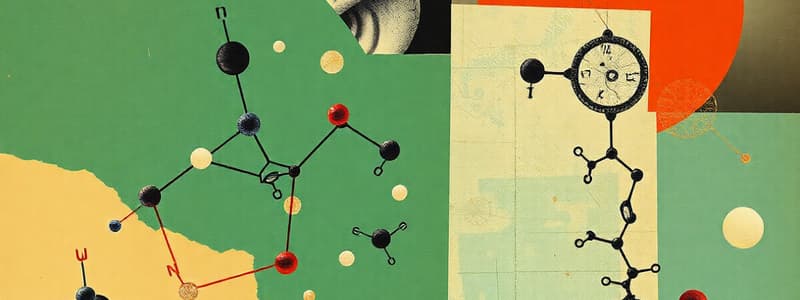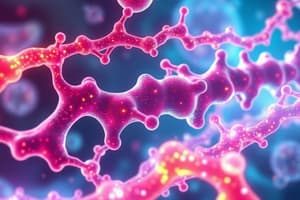Podcast
Questions and Answers
What is the role of disulfide bonds in the structure of chymotrypsin?
What is the role of disulfide bonds in the structure of chymotrypsin?
- They catalyze the reaction with substrates.
- They stabilize the polypeptide backbone of the enzyme. (correct)
- They connect the enzyme to its inhibitors.
- They serve as a substrate for enzymatic reactions.
Under what condition does the Michaelis-Menten equation simplify to V0 = Vmax?
Under what condition does the Michaelis-Menten equation simplify to V0 = Vmax?
- When the substrate concentration exceeds Km significantly. (correct)
- When the enzyme concentration is significantly higher than the substrate concentration.
- When the substrate concentration is negligible compared to Km.
- When the reaction is at equilibrium.
Which of the following statements about enzyme kinetics is true?
Which of the following statements about enzyme kinetics is true?
- Kinetics can help identify enzyme inhibitors. (correct)
- Enzyme kinetics only considers the rate of product formation.
- The total enzyme concentration is assumed to change during the reaction.
- The Michaelis-Menten equation does not apply under first-order conditions.
What is the primary role of enzymes in biochemical processes?
What is the primary role of enzymes in biochemical processes?
What is indicated by a linear dependence of V0 on substrate concentration [S] in enzyme kinetics?
What is indicated by a linear dependence of V0 on substrate concentration [S] in enzyme kinetics?
Which of the following describes the specificity of enzymes compared to inorganic catalysts?
Which of the following describes the specificity of enzymes compared to inorganic catalysts?
What does the term Km represent in the context of the Michaelis-Menten equation?
What does the term Km represent in the context of the Michaelis-Menten equation?
What is one advantage of enzymatic catalysis in biological systems?
What is one advantage of enzymatic catalysis in biological systems?
How do enzymes aid in reaching thermodynamic equilibrium?
How do enzymes aid in reaching thermodynamic equilibrium?
Why is enzymatic catalysis preferred over inorganic catalysis?
Why is enzymatic catalysis preferred over inorganic catalysis?
What characteristic of enzymes contributes to their effectiveness in biological processes?
What characteristic of enzymes contributes to their effectiveness in biological processes?
What is a downside of using inorganic catalysts in biological systems?
What is a downside of using inorganic catalysts in biological systems?
What role do enzymes play in the decomposition of metabolites?
What role do enzymes play in the decomposition of metabolites?
What is primarily optimized in enzyme active sites to facilitate a reaction?
What is primarily optimized in enzyme active sites to facilitate a reaction?
Which catalytic mechanism involves the formation of a transient covalent bond between the enzyme and substrate?
Which catalytic mechanism involves the formation of a transient covalent bond between the enzyme and substrate?
Which of the following is NOT a function of metal ions in enzyme catalysis?
Which of the following is NOT a function of metal ions in enzyme catalysis?
What is the primary role of enzymes in reactions according to the transition state theory?
What is the primary role of enzymes in reactions according to the transition state theory?
Which amino acid residues are involved in general acid-base catalysis?
Which amino acid residues are involved in general acid-base catalysis?
Chymotrypsin is a type of enzyme known for cutting peptides. What type of reaction does it catalyze?
Chymotrypsin is a type of enzyme known for cutting peptides. What type of reaction does it catalyze?
In covalent catalysis, what type of molecule is typically a nucleophile?
In covalent catalysis, what type of molecule is typically a nucleophile?
What term describes the phenomenon where binding energy assists enzyme conformation?
What term describes the phenomenon where binding energy assists enzyme conformation?
What is the primary structural requirement for an enzyme's catalytic activity?
What is the primary structural requirement for an enzyme's catalytic activity?
Which of the following describes the function of ligases?
Which of the following describes the function of ligases?
Enzyme activity can be affected by which of the following?
Enzyme activity can be affected by which of the following?
How is the enzyme-substrate complex characterized?
How is the enzyme-substrate complex characterized?
What role do prosthetic groups play in enzyme function?
What role do prosthetic groups play in enzyme function?
Which class of enzymes catalyzes group transfer reactions?
Which class of enzymes catalyzes group transfer reactions?
What is a common function of hydrolases?
What is a common function of hydrolases?
Which statement is true about enzymes' effect on equilibrium constants?
Which statement is true about enzymes' effect on equilibrium constants?
What defines an enzyme's substrate selectivity?
What defines an enzyme's substrate selectivity?
What is required for an enzyme to be considered a holoenzyme?
What is required for an enzyme to be considered a holoenzyme?
What characterizes irreversible inhibitors in enzyme inhibition?
What characterizes irreversible inhibitors in enzyme inhibition?
Which of the following statements about competitive inhibition is true?
Which of the following statements about competitive inhibition is true?
In uncompetitive inhibition, what happens to Vmax and KM?
In uncompetitive inhibition, what happens to Vmax and KM?
What is the main characteristic of mixed inhibition?
What is the main characteristic of mixed inhibition?
Which graphical characteristic indicates competitive inhibition in a Lineweaver-Burk plot?
Which graphical characteristic indicates competitive inhibition in a Lineweaver-Burk plot?
Flashcards are hidden until you start studying
Study Notes
Principles of Enzymatic Catalysis
- Enzymes act as catalysts in biochemical processes.
- They increase reaction rates without being consumed in the process.
- Enzymes accelerate both the forward and reverse reactions, driving systems towards equilibrium faster.
Advantages of Biocatalysis
- Greater reaction specificity: Enzymes minimize the formation of unwanted side products.
- Milder reaction conditions: Enzymes operate effectively in the physiological environment of cells, at pH ~ 7 and 37°C.
- Higher reaction rates: Enzymes allow for efficient biochemical processes within the timescale of biological systems.
- Regulation and control: Enzymes play a crucial role in regulating and controlling metabolic pathways.
Enzymes in Disease
- Enzyme levels and activities can serve as biomarkers for diagnosing diseases.
- Changes in enzyme concentrations or activities are indicative of specific disease states.
- Many medications target and interact with specific enzymes.
Enzyme Structure and Function
- Most enzymes are globular proteins, with catalytic activity dependent on their native folded structure, including primary, secondary, tertiary, and quaternary structures.
- Some RNA molecules, like ribozymes and ribosomal RNA, have catalytic properties.
- Prosthetic groups, such as cofactors (inorganic ions) and coenzymes (organic molecules), can be critical for enzymatic activity.
- Apoenzyme: the protein component of an enzyme without its prosthetic group
- Holoenzyme: the active complex formed by the apoenzyme and its prosthetic group(s).
Enzyme Classification
- The International Classification of Enzymes (ICE) categorizes enzymes into six classes based on their catalytic activity:
- Oxidoreductases: Catalyze electron transfer reactions.
- Transferases: Transfer functional groups between molecules.
- Hydrolases: Break bonds through the addition of water.
- Lyases: Cleave bonds by mechanisms other than hydrolysis or oxidation.
- Isomerases: Rearrange atoms within a molecule.
- Ligases: Join two molecules by forming new bonds, often requiring ATP or cofactors.
Enzyme Substrate Selectivity
- Enzymes exhibit high specificity for their substrates, binding to specific molecules while excluding others.
- This selectivity arises from the complementary fit between the enzyme's active site and the substrate.
- Example: phenylalanine hydroxylase specifically acts on phenylalanine.
- Enzyme-Substrate Complex: The binding of a substrate to an enzyme's active site forms a crucial intermediate complex, facilitating the catalytic process.
How Enzymes Lower Activation Energy
- Transition State Stabilization: Enzymes bind to the transition state of a reaction more strongly than they bind to the substrate.
- This stabilization lowers the activation energy (ΔG‡), accelerating the reaction.
- Proximity Model: The close proximity of reactive groups within the active site enhances their interaction, leading to faster reaction rates.
Catalytic Mechanisms of Enzymes
- Common mechanisms employed by enzymes:
- Acid-Base Catalysis: Amino acid residues donate or accept protons to facilitate proton transfer.
- Covalent Catalysis: Transient covalent bonds form between the enzyme and the substrate, changing the reaction pathway.
- Metal Ion Catalysis: Metal ions are incorporated into the active site for various roles, including:
- Stabilizing negative charges
- Facilitating substrate binding
- Participating in redox reactions
Chymotrypsin: A Case Study
- Chymotrypsin is a protease involved in protein digestion.
- It cleaves peptide bonds adjacent to aromatic amino acids.
- Chymotrypsin effectively uses multiple catalytic mechanisms, including acid-base, covalent, and metal ion catalysis.
Enzyme Kinetics
- Kinetics: Study of the rates of chemical reactions.
- Factors influencing enzymatic reaction rates:
- Enzyme concentration
- Substrate concentration
- Effectors (activators or inhibitors)
- Temperature
- Applications of enzyme kinetics:
- Quantitative description of enzymatic catalysis
- Elucidation of substrate binding order
- Understanding catalytic mechanisms
- Discovery of effective inhibitors
- Investigation of enzyme activity regulation
Enzyme Inhibition:
- Irreversible Inhibitors (inactivators): permanently inactivate the enzyme, forming a strong complex.
- Reversible Inhibitors: bind to and dissociate from the enzyme, slowing down its activity.
- Reversible inhibitor types:
- Competitive: Inhibitor and substrate compete for binding to the active site.
- Uncompetitive: Inhibitor binds only to the enzyme-substrate complex (ES).
- Mixed: Inhibitor binds to the enzyme with or without substrate, affecting both substrate binding and catalysis.
Effects of Inhibition on Enzyme Kinetics:
- Competitive Inhibition:
- No change in Vmax (maximum velocity)
- Apparent increase in Km (Michaelis-Menten constant, representing the substrate concentration at half Vmax)
- Lineweaver-Burk plot: lines intersect at the y-axis.
- Uncompetitive Inhibition:
- Decrease in Vmax
- Apparent decrease in Km
- No change in Km/Vmax
- Lineweaver-Burk plot: lines are parallel.
- Mixed Inhibition:
- Decrease in Vmax
- Apparent change in Km
- Lineweaver-Burk plot: lines intersect left to the y-axis.
Studying That Suits You
Use AI to generate personalized quizzes and flashcards to suit your learning preferences.




